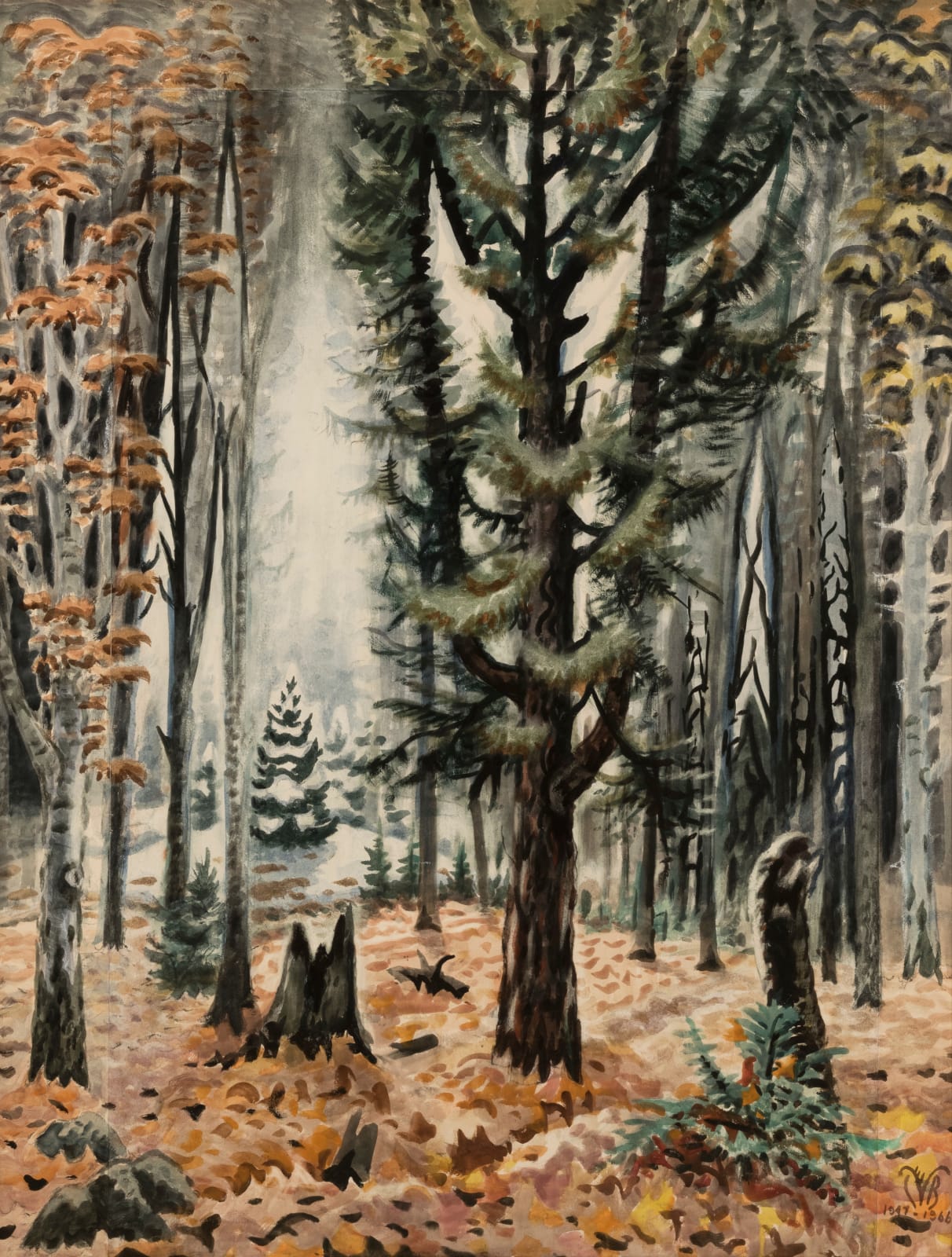Charles Burchfield
106.7 x 82.5 cm
Charles E. Burchfield, Journals, November 5, 1947
Low-hanging skies and some drizzling rain.
The Belscher Rd. Country is wild and densely wooded. Before lunch a short walk in a woods. The tall somber trees, deep-glowering hemlocks, a little rain falling – the rich wet leaves on the floor of the woods, a feeling of a vast out door room --- the white violet, which I dug up for B --- Smooth-barked hickory, a few of which I picked up. The exciting acrid odor of the hills.
After lunch, set up my sketching outfit and soon at work painting (a tall gloom-filled hemlock and surrounding trees) - How good it was to be painting again, after more than three months. I felt surrounded by the goodness and kindness of god. All afternoon a jay kept up his scolding – a fine but unusual sound – once a nuthatch.
Finish at later afternoon, when a break occurred in the clouds, and the whole woods was bathed in a rich warm yellow light. A brief excursion out a ravine, then start for home. On the Trevett Rd. up the hill, stop by a woods and go in. Deep twilight – the majestic gloom was at once, both awe-inspiring and frightening. All at once I felt that I was the most lonely person on earth, and it seemed to me I would not endure the solitude, and yet it was so overpowering I could not leave it. I was, as it were, a prisoner who loved and hated his isolation. A wood-pecker busily concerned about finding his food, tapping on an ancient beech. Beyond the woods a farmer calling his cows, in a strange sing-song high pitched voice, somehow an unpleasant sound, born of necessity and not his love of life.
Nancy Weekly writes: "Hemlock in November is a bold work that expresses Charles Burchfield’s empathy with the natural world. His paintings from the last five years of his life were increasingly dreamlike; in this case, capturing the essence of a quiet snowfall in the interior of a forest surrounded by the muted tonalities of late autumn.
In the foreground, a large evergreen with branches extending beyond the picture plane sets a stately tone, which is reinforced by a lattice-like effect in nearby trees that recalls the tracery of Gothic windows. Burchfield often referenced the Gothic arch in his work, with its connotations of spirituality, linking it with arching trees and, in some cases, explicit cathedral-like forest structures in paintings with revealing titles such as Eye of God in the Woods (1949) and Glory to God (1953).
Among the other prominent trees in the painting is the one at left, perhaps a birch, which retains some of its foliage, while all around, the forest floor is covered in the yellows, browns, and oranges of fallen leaves. Deeper in the woods, it is snowing, covering smaller evergreens and the surrounding area in a hushed white. The overall impression is of a luminous glow radiating from a central patch of forest as if it contained some sort of pantheistic spirit.
Believed to be among his last paintings, Hemlock in November was begun in 1947 near Gowanda, New York, south of Buffalo, and finished almost twenty years later. Throughout his career, Burchfield built upon a repertoire of images and motifs, creating abiding consistencies of place, theme, and composition through a variety of stylistic developments. This continuity gives his late work the strength of a lifetime of insight and inspiration.
Hemlock in November and other paintings from the 1960s demonstrate that Burchfield maintained his full creative power until the end of his life. A review of an exhibition in 1966, three months before he died, noted that: 'The new exhibition of 16 large watercolors, completed within the last five years, must surely be the freshest, most attractive Burchfield show yet . . . He has not greatly changed or enlarged the manner in which he has been painting since the mid-nineteen-forties (an expressionist celebration of nature with occasional echoes, however faint, of his former preoccupation with the American scene), but he has never painted with a surer touch or a more delicate one. He has never caught us up more effectively into his poetic vision of sunlight (or moonlight), skies, wind and flowers (or winter trees).'" www.burchfieldpenney.org
Provenance
The artist; toCharles E. Burchfield Foundation; to
[Kennedy Galleries, New York]; to
George Strichman, New York; to
[Kennedy Galleries, New York]; to
Private collection; to
[DC Moore Gallery, New York, 2009]; to
Karen and Kevin Kennedy Collection, New York, until the present






